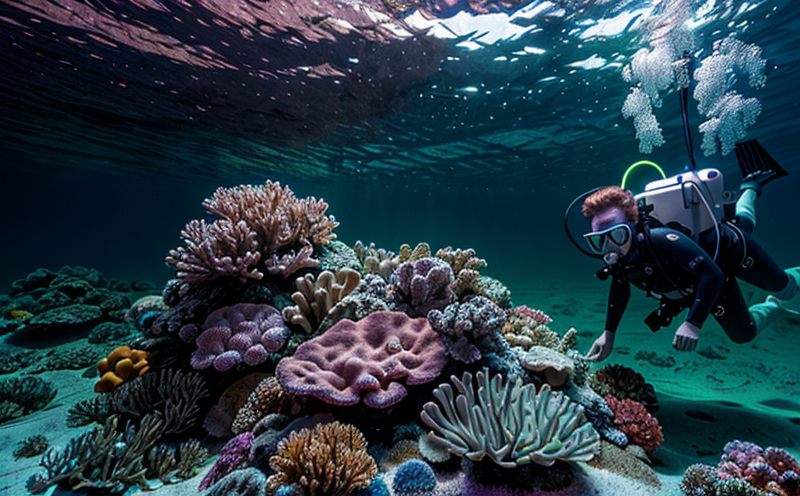ASTM D1149 Ozone Resistance Testing of Rubber Seals in Underwater Lighting
The ASTM D1149 test method is widely recognized for its rigorous evaluation of the resistance of rubber materials to ozone. This standard plays a critical role in ensuring that rubber seals used in marine and underwater lighting systems maintain their integrity under harsh environmental conditions, including exposure to ozone-rich atmospheres.
In the context of marine environments, particularly in offshore installations, underwater lighting fixtures are exposed to various stressors such as saltwater, temperature fluctuations, pressure variations, and UV radiation. Rubber seals within these fixtures serve a vital role by preventing water ingress and ensuring proper electrical connections. These seals must withstand not only mechanical stresses but also chemical degradation over extended periods.
ASTM D1149 provides a standardized approach to simulating the effects of ozone exposure on rubber materials, which is especially important for underwater lighting systems where prolonged immersion in seawater can accelerate material aging and failure due to the presence of dissolved oxygen and other oxidizing agents. The test involves exposing rubber samples to controlled concentrations of ozone under specific temperature conditions. By following this protocol, manufacturers and quality managers can ensure that their products meet industry standards and perform reliably over time.
The importance of ASTM D1149 cannot be overstated in ensuring the reliability and longevity of underwater lighting systems. This standard helps prevent costly downtime and maintenance by identifying potential issues early on during product development or manufacturing processes. It also supports regulatory compliance, which is crucial for businesses operating within heavily regulated sectors like marine engineering.
To summarize, ASTM D1149 offers a critical tool for assessing the durability of rubber seals employed in underwater lighting fixtures. By adhering to this standard, manufacturers can enhance product performance and extend operational lifetimes, thereby contributing significantly to overall system reliability.
Why It Matters
The significance of ASTM D1149 cannot be overstated when it comes to ensuring the durability and longevity of rubber seals used in marine and underwater lighting systems. These fixtures operate under challenging conditions, where they are subjected to continuous immersion in seawater, exposure to UV radiation, and fluctuations in temperature and pressure.
One of the key challenges faced by rubber seals in such environments is their susceptibility to degradation due to ozone. Ozone, a highly reactive form of oxygen, can easily penetrate materials like rubber over time, leading to cracking, hardening, or embrittlement. This degradation not only compromises the seal's effectiveness but also poses risks for the entire lighting system.
By undergoing ASTM D1149 testing, manufacturers and quality managers gain valuable insights into how well their seals will perform under real-world conditions. The test simulates exposure to ozone-rich environments, providing a reliable measure of the seal's resistance over time. This information is invaluable for R&D teams looking to optimize material selection or improve existing designs.
Moreover, compliance with ASTM D1149 helps ensure that products meet stringent industry standards and regulatory requirements. For companies operating in heavily regulated sectors such as marine engineering, this can mean the difference between successful market entry and potential legal challenges. Additionally, it enhances customer trust by demonstrating commitment to quality and reliability.
Ultimately, ASTM D1149 testing is essential for safeguarding both product integrity and end-user satisfaction. By addressing ozone resistance early in the design phase or during production processes, manufacturers can significantly reduce the likelihood of premature failures, which would otherwise lead to increased warranty claims, repair costs, and reputational damage.
Applied Standards
| Standard | Description |
|---|---|
| ASTM D1149-18 | This standard specifies the procedure for determining the resistance of rubber to ozone at elevated temperatures. |
| ISO 3205:2017(E) | An international standard that provides guidance on testing and evaluating the effects of environmental exposure on rubber materials, including those used in underwater applications. |
| EN ISO 9864-1:2009 | A European standard that outlines methods for determining the resistance to ozone and other oxidants of thermoplastic elastomers and similar materials. |
The application of these standards ensures consistent testing protocols across various regions, promoting global compatibility and acceptance. Compliance with such internationally recognized standards adds credibility to your product offerings, making them more attractive to potential customers who operate in multiple jurisdictions or adhere strictly to international norms.
Competitive Advantage and Market Impact
- Enhances product performance by ensuring long-term durability against environmental stressors.
- Promotes regulatory compliance, thereby reducing the risk of legal challenges or non-conformance issues.
- Bolsters customer trust through demonstrated commitment to quality and reliability.
- Aids in optimizing material selection for new product development or enhancing existing designs.
By adhering to ASTM D1149, manufacturers not only meet essential industry standards but also gain a competitive edge by delivering superior products that perform consistently across diverse marine environments. This ensures sustained customer satisfaction and fosters long-term business relationships within the sector.





